Introduction:
Welcome, aspiring aquarists! Are you ready to dive into the fascinating world of aquarium care? Consider the most crucial aspect of keeping a healthy and thriving aquatic ecosystem is maintaining water quality. In this beginner’s guide, we will explore simple yet effective practices to ensure the well-being of your fishy friends, shedding light on the following;
The Importance of Water Quality
Water quality is of utmost importance in maintaining a healthy and thriving aquarium ecosystem. It directly impacts the well-being of aquatic plants, fish and other inhabitants. Optimal water quality ensures that the aquatic environment provides the necessary conditions for growth, reproduction, and overall vitality.
One key aspect of water quality is maintaining appropriate chemical parameters. pH levels, ammonia, nitrite, nitrate levels, dissolved oxygen, and water hardness should be within suitable ranges for the specific species in your aquarium. These parameters affect the ability of plants to absorb nutrients, the respiratory functions of fish, and the overall balance of the ecosystem.
Additionally, water temperature plays a crucial role in aquatic life. Different species have specific temperature requirements, and maintaining a stable and suitable temperature range is essential for their well-being. Sudden fluctuations in temperature can cause stress, compromise immune systems, and even lead to mortality.
Furthermore, proper filtration is vital for maintaining water quality. A reliable filtration system removes physical debris, excess nutrients, and harmful substances, ensuring a stable and clean environment. Mechanical filtration removes large particles, while biological filtration breaks down toxic substances through beneficial bacteria.
Regular monitoring and testing of water parameters, along with regular water changes, are essential to prevent the accumulation of harmful substances and maintain a healthy balance. Adjustments can be made as needed to correct any imbalances and provide optimal conditions for the growth and development of aquatic plants and fish.
Maintaining high water quality is crucial for the long-term health and success of your aquarium. It promotes the growth of aquatic plants, supports the well-being of fish and other inhabitants, and contributes to a visually appealing and harmonious ecosystem.
Regular Water Testing
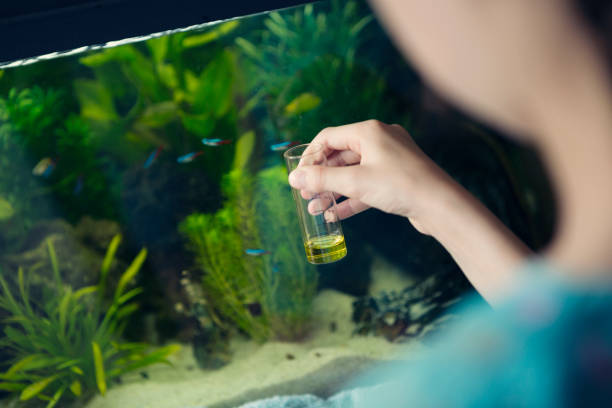
Maintaining a healthy and thriving aquarium ecosystem involves periodically analyzing various chemical parameters to ensure that the water conditions are suitable for the aquatic inhabitants.
Testing for parameters such as pH, ammonia, nitrite, nitrate levels, dissolved oxygen, and water hardness provides crucial information about water quality. These parameters directly impact the well-being of plants, fish, and other aquatic organisms. Monitoring these levels helps to detect any imbalances or potential issues in the aquarium.
By conducting regular water tests, you can identify and address problems before they become severe. For example, high levels of ammonia or nitrite can be toxic to fish and indicate an issue with the nitrogen cycle. Testing for these parameters allows you to take corrective measures such as adjusting the filtration system, performing water
changes, or adding beneficial bacteria to restore the balance.
Regular water testing also helps in maintaining stable conditions. Slight fluctuations in pH or other parameters can stress the aquarium inhabitants and compromise their health. By monitoring these levels, you can make necessary adjustments to keep the water parameters within the appropriate range, providing a stable and suitable
environment for aquatic life.
Testing your water regularly is very crucial for preventing potential problems, ensuring the well-being of your aquarium inhabitants, and maintaining a healthy and balanced ecosystem. It allows you to proactively address any issues and create optimal conditions for the growth and vitality of your aquatic plants and fish. Test kits are available for purchase at aquarium supply stores and online.
Ammonia and Nitrite Control
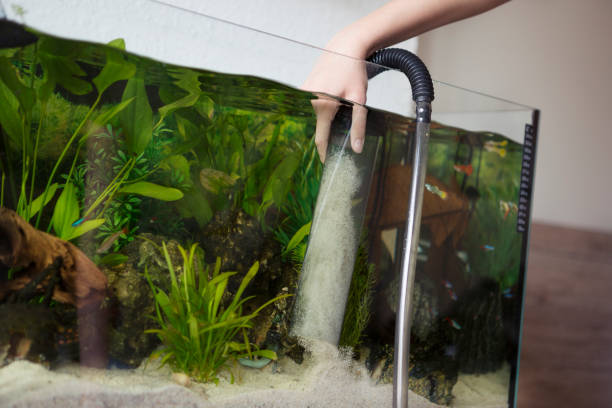
These are toxic substances that can harm your fish if present in high concentrations. Ammonia is highly toxic to fish, while nitrite is also harmful in elevated concentrations. Both ammonia and nitrite are produced as byproducts of fish waste, uneaten food, and decaying organic matter.
To control ammonia and nitrite levels, a well-functioning biological filtration system is necessary. Beneficial bacteria in the aquarium’s filter convert toxic ammonia into nitrite, and then into less harmful nitrate through the nitrogen cycle.
To ensure effective ammonia and nitrite control, several measures can be taken.
First, establish a mature biological filter by providing a sufficient surface area for bacteria colonization. This can be achieved through the use of filter media, such as bio balls or ceramic rings.
Second, avoid overfeeding the fish and promptly remove any uneaten food to prevent excess ammonia production.
Third, perform regular water testing to monitor ammonia and nitrite levels and take appropriate actions if they exceed safe limits. This may include partial water changes, adding beneficial bacteria supplements, or reducing the stocking density of fish.
Maintaining a healthy nitrogen cycle and controlling ammonia and nitrite levels is vital for the overall well-being of aquarium inhabitants, ensuring their longevity and minimizing stress-related diseases.
Performing Regular Water Changes
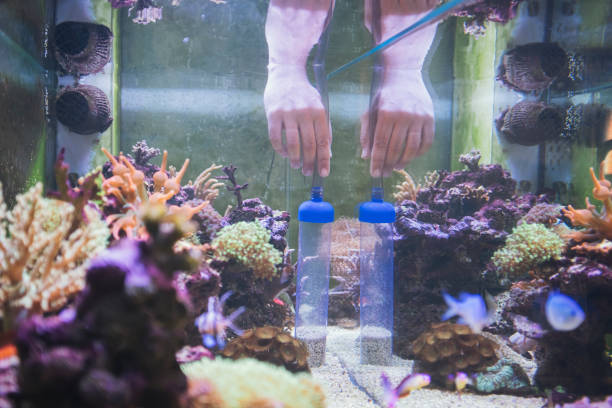
Water changes are like a breath of fresh air for your aquarium. They help remove accumulated toxins, excess nutrients, and waste products that can lead to poor water quality. Aim to perform regular partial water changes, replacing around 10-25% of the water every one to two weeks. During a water change, a portion of the aquarium water is siphoned out and replaced with fresh, conditioned water.
This dilutes pollutants and restores the balance of essential minerals and elements. It also helps control ammonia,
nitrite, and nitrate levels, preventing their buildup. The frequency and amount of water changes depend on various factors such as the size of the tank, the number of inhabitants, and the filtration system. As a general guideline, aim for a 10-20% water change every one to two weeks. However, closely monitor water parameters to determine the ideal frequency and volume for your specific setup.
Remember to use a water conditioner to remove chlorine and chloramine from tap water before adding it to the aquarium. Regular water changes, combined with proper filtration and maintenance, promote the health and longevity of your aquatic pets, reducing the risk of diseases and ensuring a vibrant, beautiful aquarium display.
Maintaining a Clean and Efficient Filtration System
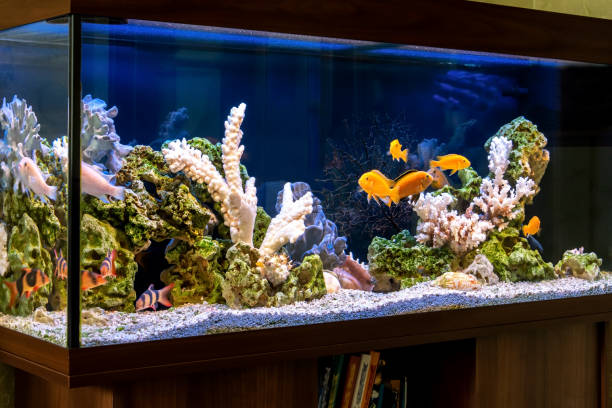
A sound filtration system is vital for maintaining water quality. It helps remove debris, excess food, and fish waste, keeping the water clear and healthy by ensuring a stable and balanced environment.
Regular maintenance of the filtration system involves several tasks. Firstly, clean or replace mechanical filtration components like filter pads or cartridges to remove physical debris. Secondly, clean the biological filtration media, such as ceramic rings or bio-balls, to prevent clogging and promote the growth of beneficial bacteria.
Additionally, ensure proper water flow by checking and cleaning the impeller, intake tubes, and output nozzles regularly. This will prevent any blockages that could hinder the filtration process. Monitoring water parameters and testing for ammonia, nitrite, and nitrate levels will help assess the efficiency of the filtration system. Adjustments or upgrades may be necessary if the filtration capacity is inadequate for the aquarium’s needs.
By maintaining your filter according to the manufacturer’s instructions to ensure optimal performance a clean and efficient filtration system promotes a healthy aquatic environment, reduces the risk of water quality issues, and provides the best possible living conditions for your aquarium inhabitants.
Proper Feeding Habits
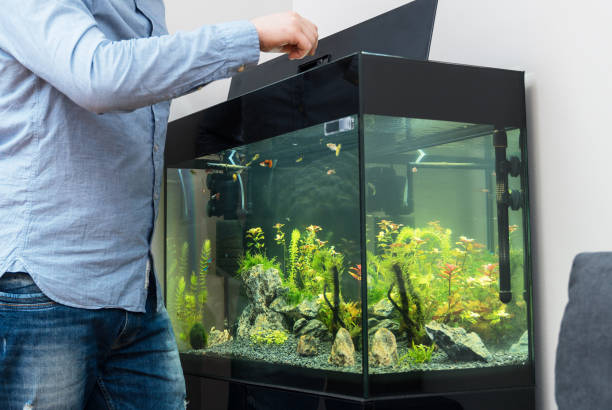
Feeding your fish appropriately plays a significant role in water quality which is crucial for the health and well-being of your aquarium inhabitants. Overfeeding can lead to excess waste causing a spike in ammonia levels.
Observe your fish during feeding to ensure they consume the food within a few minutes. Remove any uneaten food promptly to prevent it from decomposing and affecting water quality, remember, a balanced diet is essential for the health of your aquatic buddies.
Mindful Aquarium Stocking
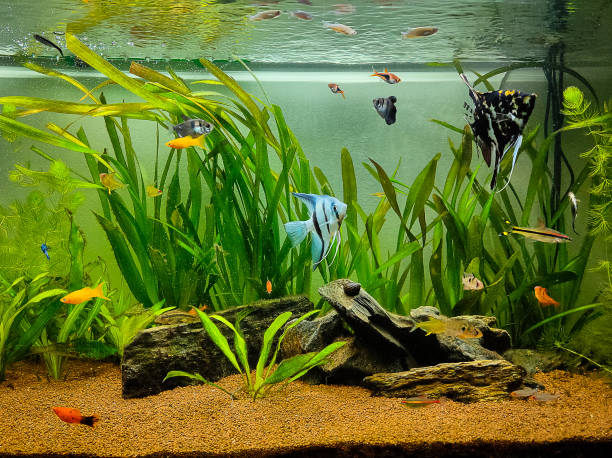
When selecting fish for your aquarium, consider their compatibility and specific environmental requirements. Overstocking can lead to increased waste production and stress for the fish, negatively impacting water quality.
Research the adult size, behavior, and compatibility of the fish species, you choose to ensure a harmonious and
sustainable aquatic community.
Maintaining a Healthy Aquatic Habitat
Creating a healthy aquatic habitat involves providing adequate hiding places, plants, and appropriate décor. Live plants not only add aesthetic appeal but also contribute to water quality by absorbing nitrates and producing oxygen.
Choose aquarium-safe decorations and structures that are easy to clean to prevent debris buildup. Consistency is key to maintaining water quality. Establish a routine for water testing, and filter maintenance once every two weeks, and regularly observe your aquarium for any signs of stress or issues with the fish, such as changes in behavior, appetite, or physical appearance. Make adjustments to the maintenance routine as necessary, keeping in mind the specific requirements of the fish and plants in your aquarium.
